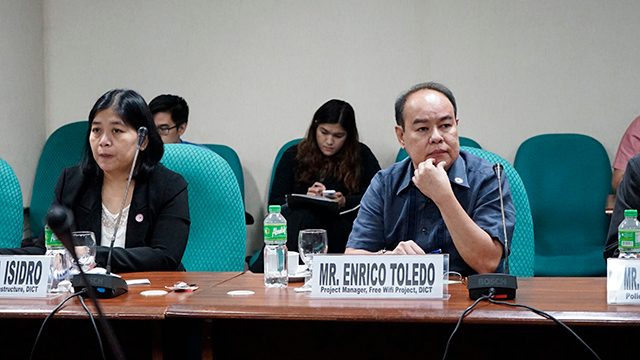SUMMARY
This is AI generated summarization, which may have errors. For context, always refer to the full article.

MANILA, Philippines – The biggest hindrance to the rollout of free public WiFi is the time it takes to get permits from local government units (LGU), an official from the Department of Information and Communication Technology (DICT) told a technical working group (TWG) meeting at the Senate on Tuesday, October 4.
In order to install or operate the necessary equipment or infrastructure in an area, the DICT and its partners have to secure a number of permits and licenses, Enrico Toledo, the project manager for the DICT’s free WiFi projects, explained.
The problem, Toledo said, is not the requirements – as they are “very simple” – but the amount of time it takes for the local government units to process the permits after the requirements have been submitted. It can take “a month or 2 or 3” before the LGUs successfully process the permits. (Read: Free Wi-Fi projects slowed down by delayed LGU permits)
Taking a month or more for LGUs to process the permits is just too long, the project manager said. The waiting time has to be reduced from months to days if the department is able to hit its target of deploying WiFi to 5,250 schools by November 2017, he said.
“Three days,” Toledo recommended.
The 5,250 schools include 347 state universities and colleges (SUC), 2,855 public high schools, and 2,048 elementary schools across the country. Before the year ends, they are targeting implementation in 668 municipalities, each with one to 2 schools.
According to Toledo, they now have “17 live sites,” which includes 15 public high schools, 1 SUC, and 1 public elementary school. (Read: Free Wi-Fi nationwide: A rundown of government initiatives)
Toledo said that if “permitting” can be loosened, there will be no problems infrastructure-wise in hitting the said targets.
Beyond the DICT initiative, the Department of Education’s (DepEd) own efforts have been able to connect 26% of the schools, said DepEd director Aida Yuvienco. “74% [of schools] are still unconnected, affecting 9 million students,” she finished.
Within the DICT hotspots, Toledo promised a minimum bandwidth of 512 kilobits per second (kbps) per user. They will also be constantly monitoring the networks to see if certain areas are growing in terms of number of concurrent users, and will increase overall bandwidth accordingly.
“We are ready for it,” said Toledo.
Not just LGUs
Also present at the hearing was Estrellita Juliano-Tamano, the national chairperson for the Federation of International Cable TV, a DICT partner.
Tamano echoed the sentiments of Toledo, stating the lack of cooperation from other agencies. She recalled a number of stories to reinforce her claim: A mayor telling them outright that they will not be issued a license; “subdivision officials” asking them to donate TV sets and CCTVs so that they’d be allowed to lay out infrastructure; and electric companies disallowing them from making use of their electric poles, asking them to buy bandwidth from them.
She was visibly aghast, expressing shock over the fact that at an electric company would require them to pay for bandwidth – a product that she says doesn’t seem to fit in an electric company’s roster of services. “We must be allowed to use the posts,” said Tamano.
“‘Yan ang nakaka-delay. Pero sabi nga ni Eric (Toledo) ‘pag nagawan ng paraan ‘tong mga pole owners and local government, in two years matatapos ang free public Wifi [rollout]. Definitely,” she finished.
(That’s what’s causing the delay. But as Eric said, if these issues with the pole owners and local government can be solved, in two years, the free public WiFi rollout can be finished. Definitely.)
The excerpts from Tamano serve to illustrate the local troubles that a national program can oftentimes encounter. Along with the length of time it takes to get permits, red tape at the most basic level cripple rather than buoy these programs.
Representatives from partner telcos and other government agencies also attended the meeting which addressed the similar provisions and sections in free WiFi bills SBN 1050 (“Free Internet in Public School Act”), SBN 58 and SBN 816 (“Free Public WiFi Act of 2016”), and SBN 190 (“Wireless Internet Access Act”). – Rappler.com
Add a comment
How does this make you feel?
There are no comments yet. Add your comment to start the conversation.